
Pennywort (Gotu Kola): Everything You Need to Know About This Herb in Vietnam
Pennywort, also known as gotu kola, is a simple green herb commonly found in Vietnam. It has a unique flavor and is used in both food and drinks. In this article, we’ll take a closer look at what pennywort is, how it’s grown and used in Vietnamese cuisine, and why it’s valued not only for its taste but also for its traditional health benefits in Vietnamese herbal medicine.
What is pennywort
Growing and harvesting
Culinary uses in Vietnam
Traditional remedies
Forms of pennywort
FAQs
What is pennywort (gotu kola)?
Overview
 Vietnamese name: rau ma
Vietnamese name: rau ma Shape and appearance: small, kidney-shaped leaves with scalloped edges, growing on slender green stems; often forming dense mats close to the ground.
Shape and appearance: small, kidney-shaped leaves with scalloped edges, growing on slender green stems; often forming dense mats close to the ground. Flavor profile: mildly grassy and slightly bitter, with refreshing earthy undertones.
Flavor profile: mildly grassy and slightly bitter, with refreshing earthy undertones.  How to enjoy it: In Vietnam, pennywort is enjoyed fresh in drinks, soups, and salads. It’s also dried for tea or ground into powder for drinks and skincare.
How to enjoy it: In Vietnam, pennywort is enjoyed fresh in drinks, soups, and salads. It’s also dried for tea or ground into powder for drinks and skincare.Shape and appearance
Pennywort (gotu kola) is a low-growing, creeping herb with soft, slender stems that are pale green or slightly purplish. Its leaves are kidney-shaped, smooth, and a darker green than the stems, with scalloped edges. The plant often spreads out to form a lush green carpet close to the ground, though in ideal conditions, it can grow upright to a height of 30 to 40 centimeters. In Vietnam, farmers typically harvest pennywort when it reaches about 15 to 20 centimeters tall—just the right size for optimal flavor and texture in tea and cooking.
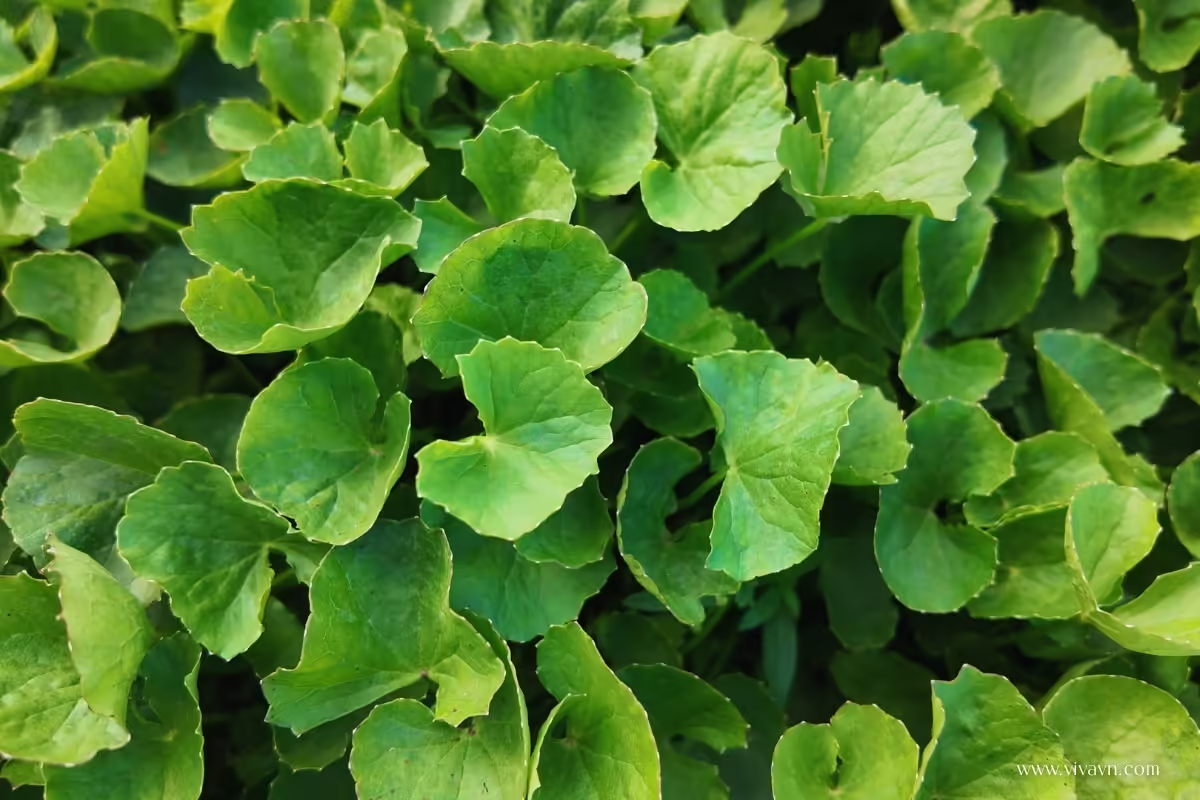
Close-up of fresh pennywort leaves (gotu kola).
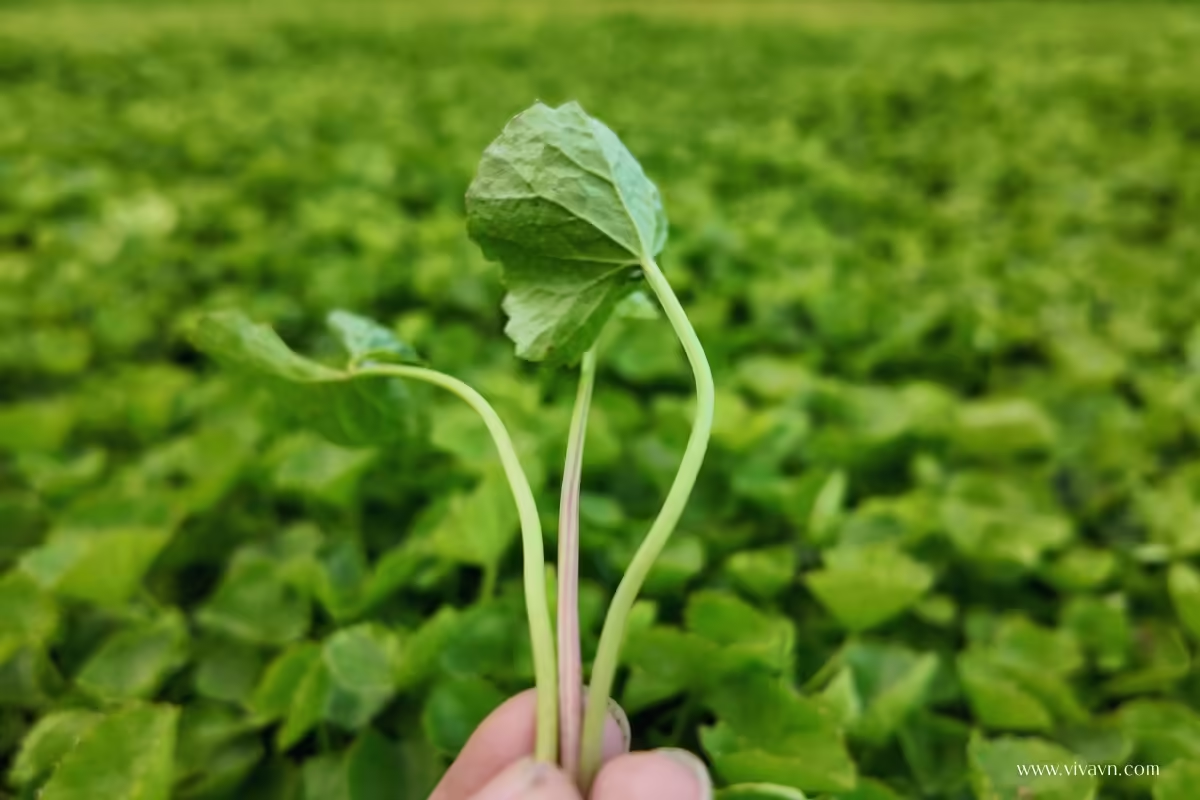
Close-up of gotu kola stems showing both pale green and purplish colors.
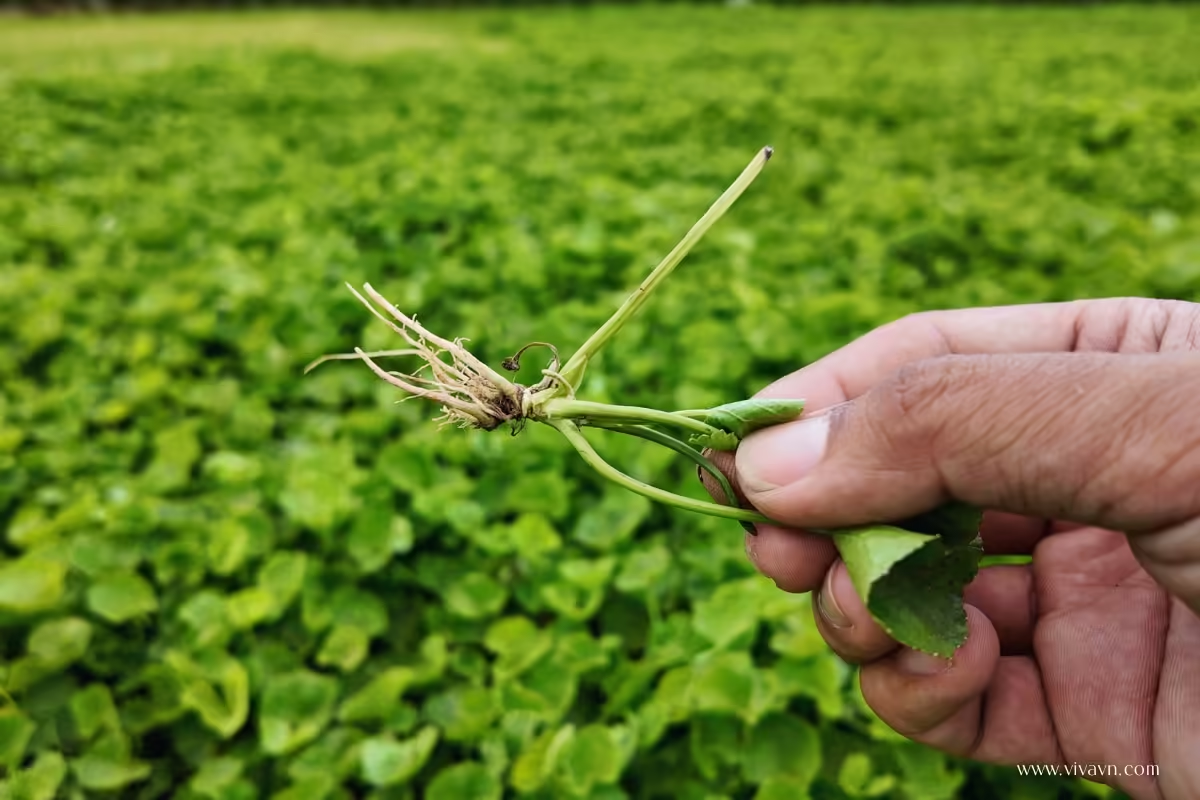
Close-up of white gotu kola roots freshly pulled from the soil.
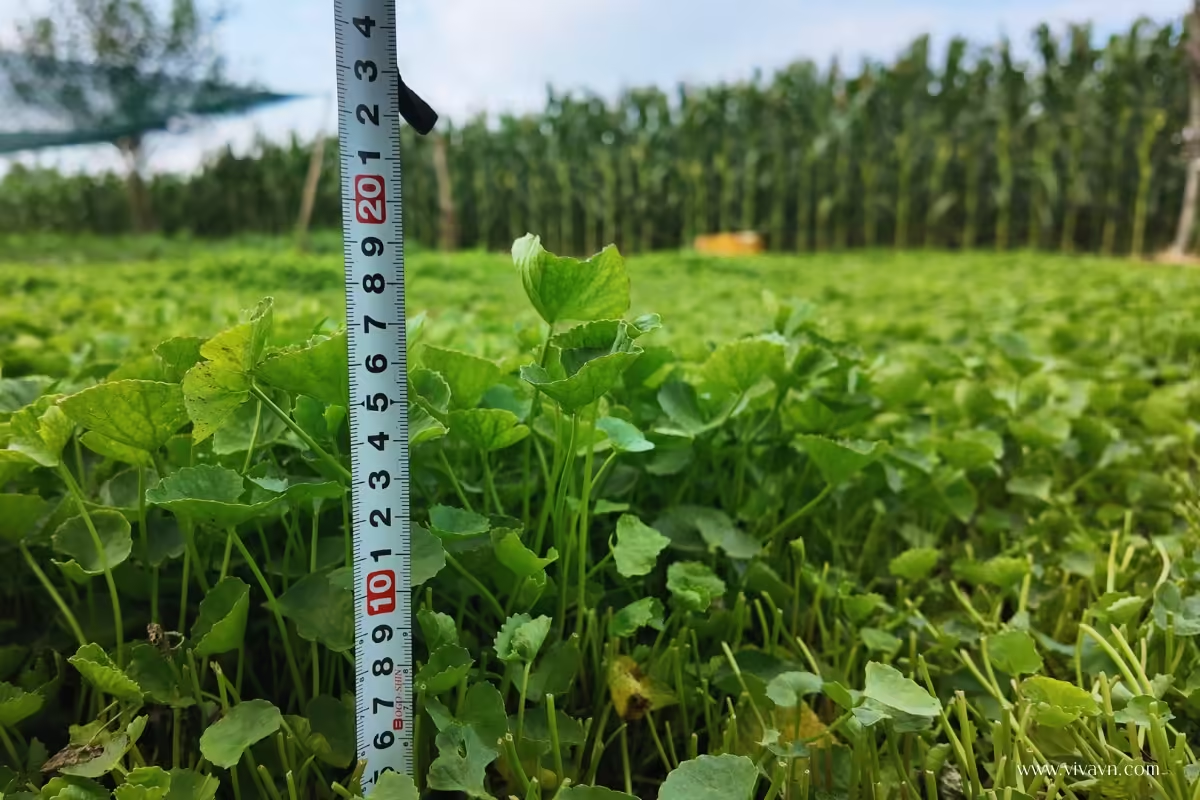
Pennywort plants are ready to harvest when they reach a height of 15 to 20 centimeters.
Where does gotu kola grow in Vietnam?
Gotu kola is a hardy herb that thrives in Vietnam’s warm, humid climate. It grows easily in home gardens, along village paths, and near ponds or lakes—anywhere with moist, shaded soil. In many rural areas, families grow pennywort for daily use or local markets. Some villages even specialize in cultivating this herb to supply ingredients for traditional teas and health drinks. One well-known example is Quang Tho, a farming community in the city of Hue, Central Vietnam, where farmers have built a reputation around growing high-quality pennywort.
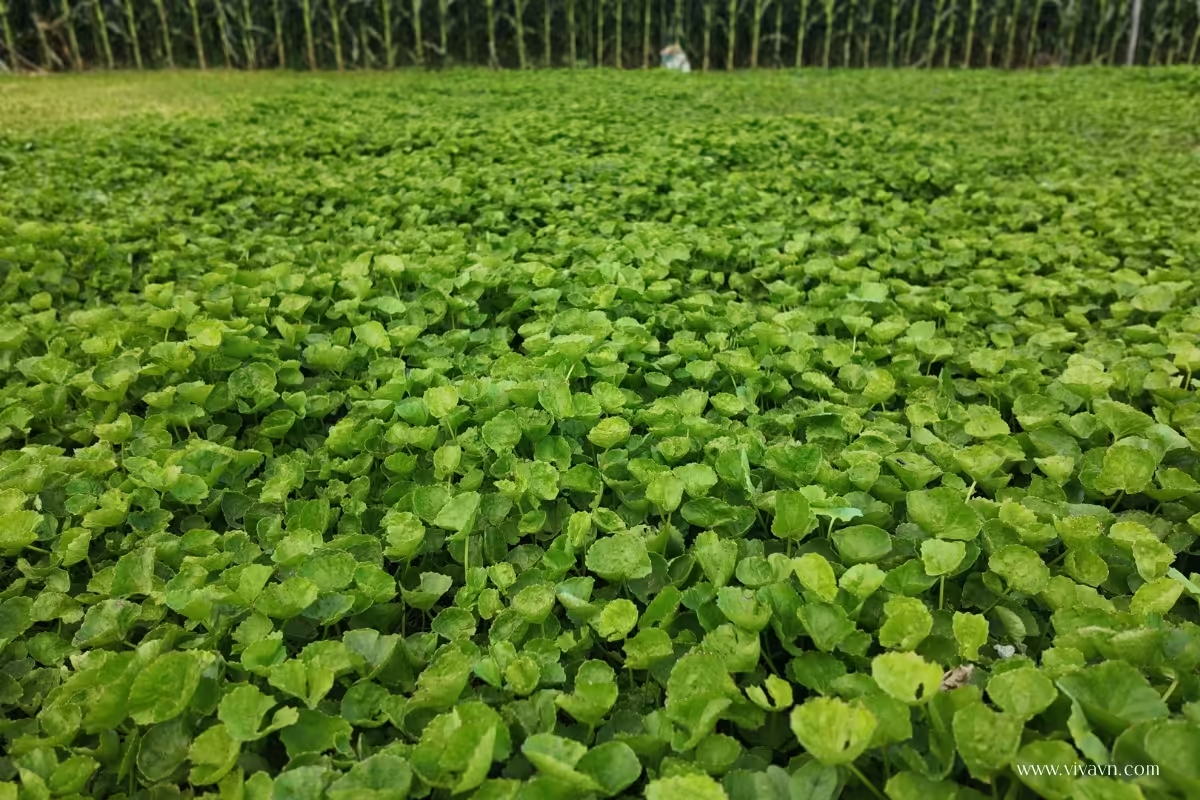
Fresh pennywort plants growing in a Vietnamese village garden for herbal tea production.
Taste and flavor
Fresh pennywort leaves have a distinct herbal aroma that some might find unfamiliar at first. When cooked at high heat, the aroma becomes even more pronounced. The taste is mildly bitter, but it often leaves a subtle, pleasant sweetness on the palate after each sip or bite.
Cultivating and harvesting pennywort (gotu kola) in Vietnam
Pennywort (gotu kola) thrives in a variety of soil conditions, but for the best yield, Vietnamese farmers prefer to grow it in loose, nutrient-rich soil. The herb can be propagated either by planting root segments or sowing seeds, with seed propagation being more common for large-scale cultivation.
After sowing, the plants typically take about two to three months to reach maturity for the first harvest. During harvesting, farmers cut the stems about 3 to 4 centimeters above the ground to encourage regrowth. The plant regenerates quickly, allowing for subsequent harvests roughly every 15 days.
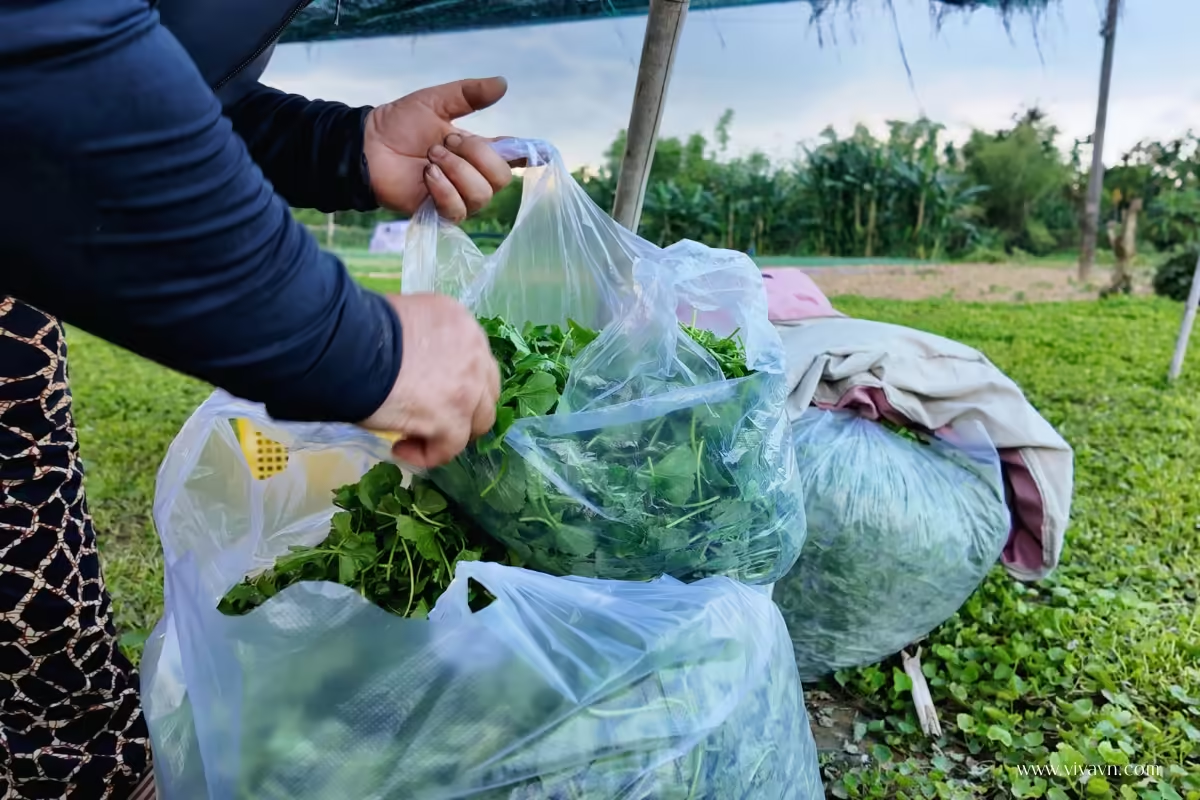
A local farmer in Vietnam prepares fresh pennywort to sell at the market after harvest.
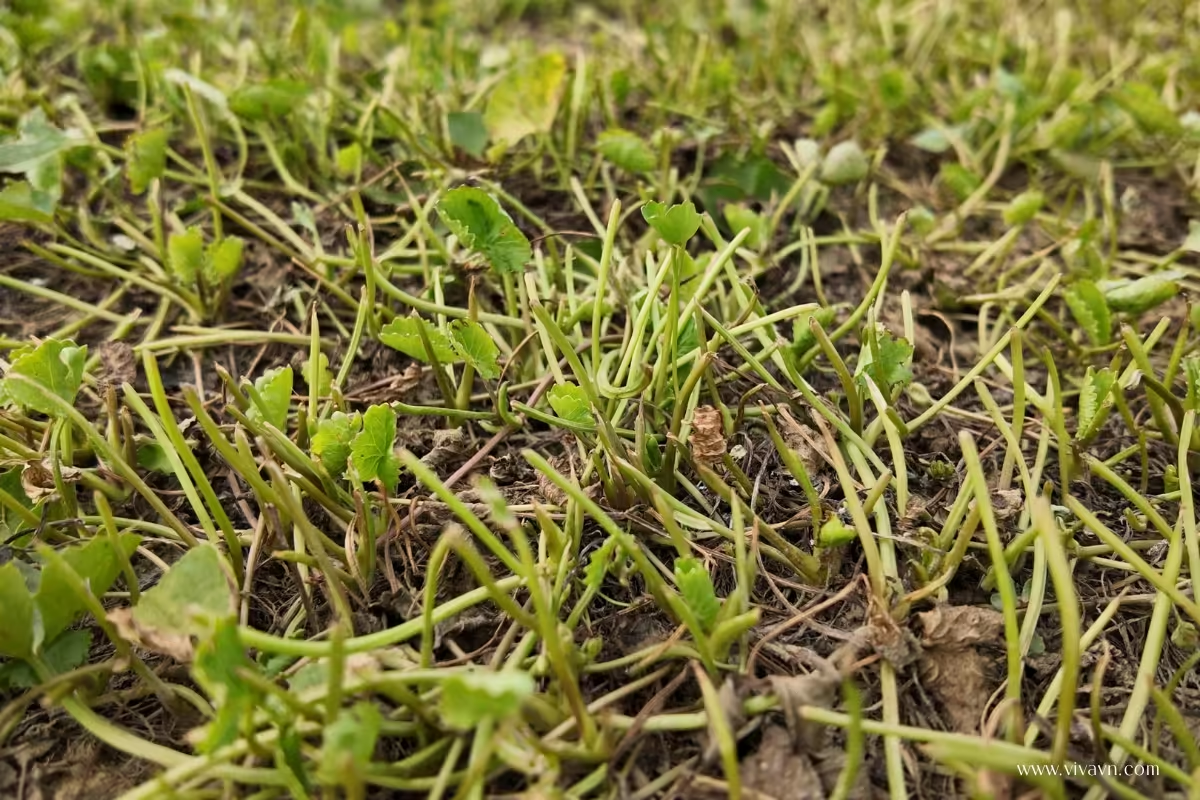
Close-up of a Vietnamese garden after pennywort (gotu kola) harvest, with only short stems and roots remaining.
Culinary uses of pennywort in Vietnam
Vietnamese pennywort and shrimp soup (canh ra ma nau tom)
One traditional way to enjoy pennywort in Vietnam is in a light soup cooked with shrimp. Known as “canh rau ma nau tom”, this comforting, home-style dish begins by sautéing seasoned shrimp with shallots until fragrant. Water is then added and brought to a boil to create a flavorful base. Finally, fresh pennywort leaves are added and briefly simmered just until tender. The result is a clear, nourishing broth with a mildly bitter, slightly sweet, and refreshing flavor, often enjoyed with rice.
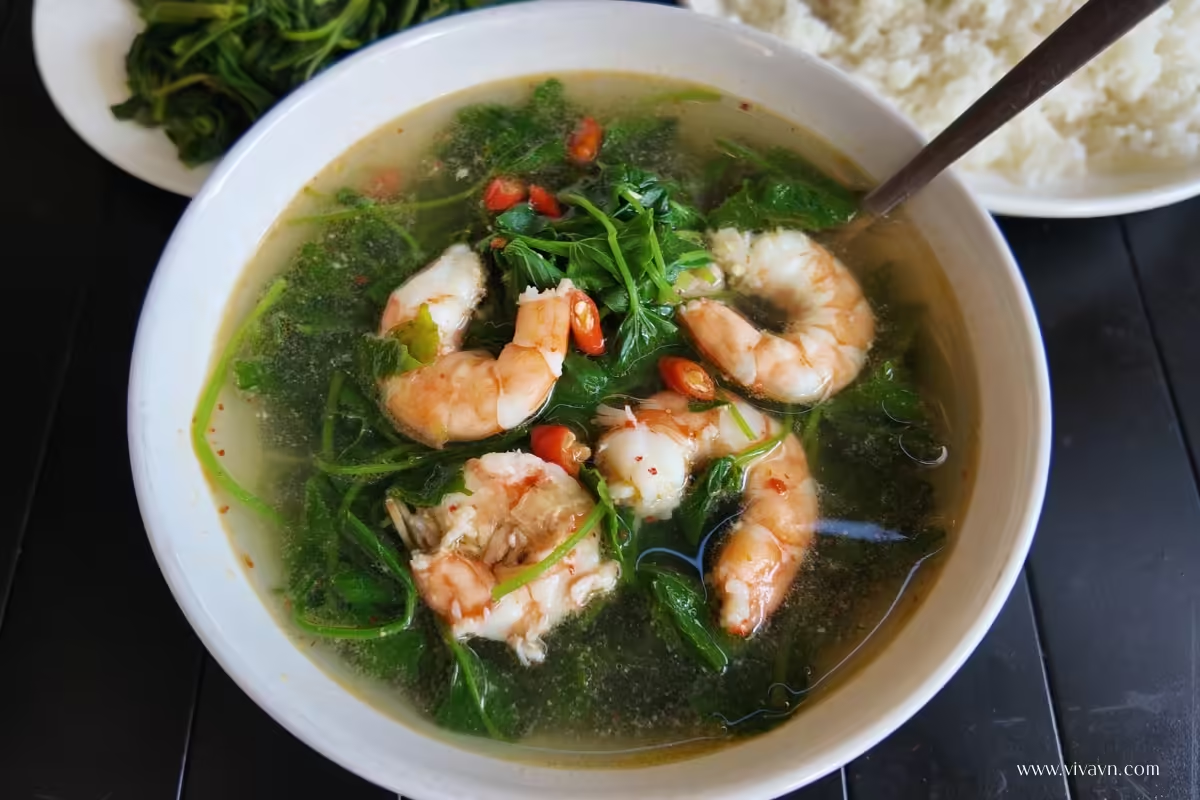
Traditional Vietnamese pennywort and shrimp soup.
Pennywort tea (tra rau ma)
One popular way to enjoy pennywort in Vietnam is as a Vietnamese herbal tea. Dried leaves are gently simmered in hot water for about 5 to 7 minutes until the brew takes on an earthy golden-brown hue. The liquid is then strained and can be enjoyed either warm or chilled. A touch of honey adds a natural sweetness, making this tea a refreshing option for hot afternoons.
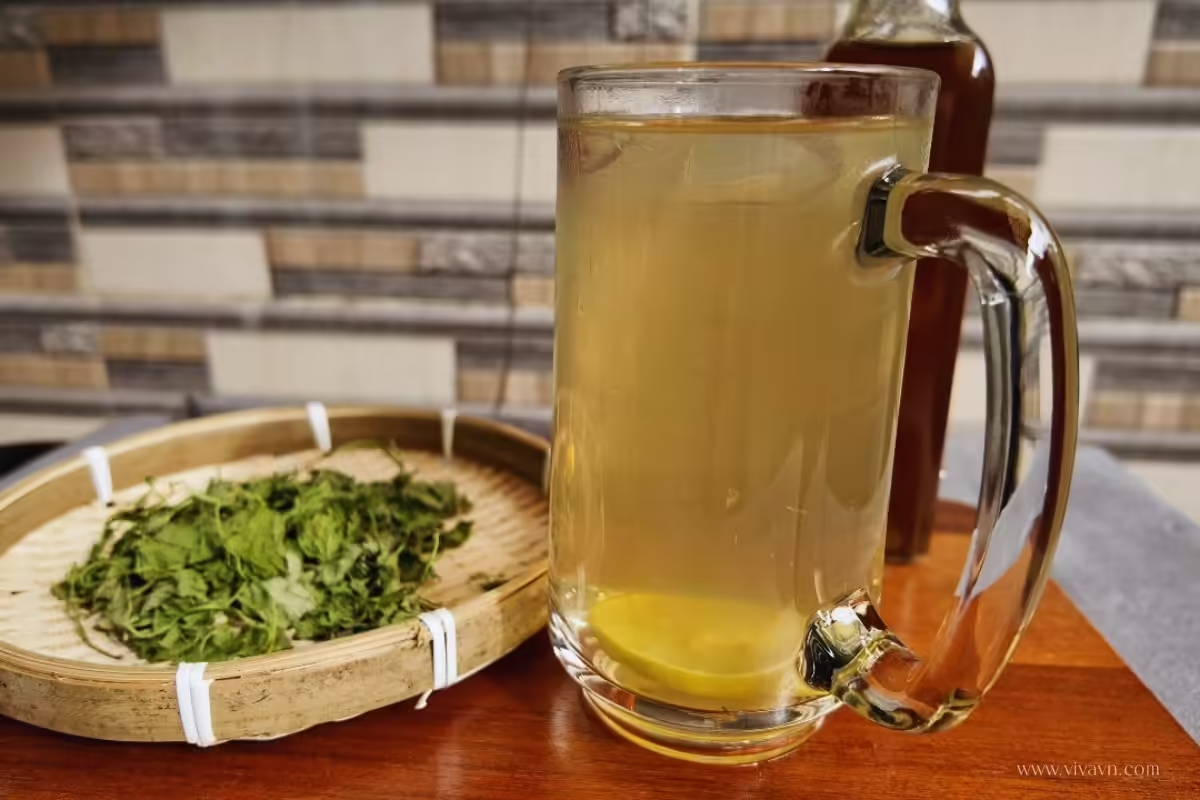
A refreshing glass of Vietnamese pennywort tea made from dried leaves, steeped with lemon and sweetened with honey.
Pennywort and mung bean smoothie (sinh to rau ma dau xanh)
In Vietnam, pennywort is often turned into a refreshing green drink. One popular version mixes it with mung beans and sweetened condensed milk to create a creamy, cooling smoothie that’s both tasty and nourishing.
Here’s a simple idea of how it’s made:
 Fresh pennywort leaves are blended with water, then strained to get the juice.
Fresh pennywort leaves are blended with water, then strained to get the juice. Soft-cooked mung beans are added for a smooth, nutty flavor.
Soft-cooked mung beans are added for a smooth, nutty flavor. A bit of sweetened condensed milk gives it a creamy and lightly sweet taste.
A bit of sweetened condensed milk gives it a creamy and lightly sweet taste.Everything is blended into a smooth, creamy drink that’s gently sweet, a little grassy, and naturally refreshing. Pour it over ice and enjoy it on a hot day.
How pennywort is used in traditional Vietnamese remedies
Note before we begin:
These uses of pennywort come from traditional Vietnamese folk remedies passed down for generations. Though still popular, they aren’t backed by modern medical research. So, think of them as cultural insights rather than medical advice.
In traditional Vietnamese remedies, pennywort is often consumed as a fresh juice to help relieve skin irritations, rashes, and acne. Some believe that drinking it daily can cool the body and support detoxification. It’s also a common ingredient in homemade beauty routines, with people claiming that it improves skin clarity and promotes a healthy glow. (Sources: Vinmec, Thanh Niên Newspaper – articles in Vietnamese)
Different forms of pennywort: fresh leaves, dried tea, and herbal powder
In Vietnam, pennywort (gotu kola) is quite versatile. Depending on the intended use, it can be prepared in several different forms.
Fresh: The most common form. Fresh pennywort leaves are used in soups, salads, and smoothies.
Dried: Pennywort leaves are dried and stored to make tea. When brewed, dried pennywort produces an earthy golden-brown infusion with a mild, grassy flavor. This method makes it easy to enjoy the herb all year round.
Powdered: Dried pennywort is sometimes ground into a fine green powder, often labeled as “pennywort powder” or “Centella asiatica powder.” This form is used to make instant herbal drinks. It’s also popular in natural skincare routines, mixed into face masks to help soothe the skin and promote a clearer complexion.
FAQs about pennywort (gotu kola)
Is pennywort the same as gotu kola?
Yes, they’re the same plant! Pennywort and Gotu Kola both refer to Centella asiatica, a low-growing herb with round, scalloped leaves. In Vietnam, it’s called “rau ma” and is a staple in traditional drinks, soups, and herbal remedies.
What is Vietnamese pennywort used for?
Vietnamese pennywort (Centella asiatica) is a versatile herb used for both culinary and wellness purposes. In Vietnam, it’s commonly made into a refreshing green juice or smoothie, often enjoyed for its naturally cooling properties. Traditionally, it’s also used in herbal remedies to support skin health, aid digestion, and help detox the body. Beyond drinks, pennywort can be added to soups, salads, or dried for tea.
Can you cook with pennywort?
Yes! In Vietnamese cooking, pennywort is added to soups, like “canh rau ma nau tom”—a light, home-style dish where fresh pennywort is gently simmered with shrimp. The result is a clean, slightly sweet broth that highlights the herb’s refreshing flavor.
Share on FacebookShare on X (Twitter)Share on PinterestShare on WhatsappShare on LinkedinShare on TelegramShare on Email
- https://www.youtube.com/@VivaVNOfficial
- https://www.facebook.com/vivavnofficial2024
- https://www.pinterest.com/vivavnofficial/
© 2025 VivaVN. All rights reserved.


Leave a Reply